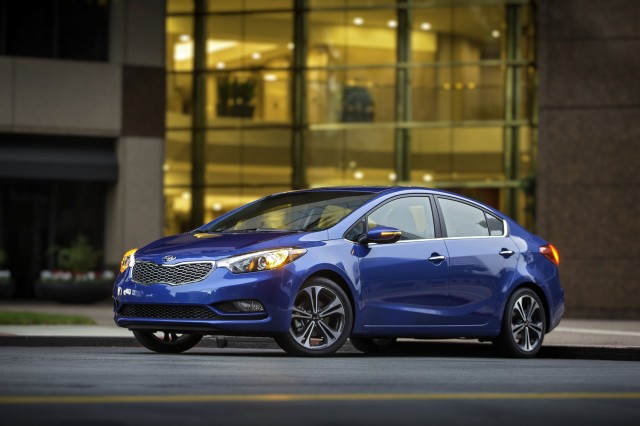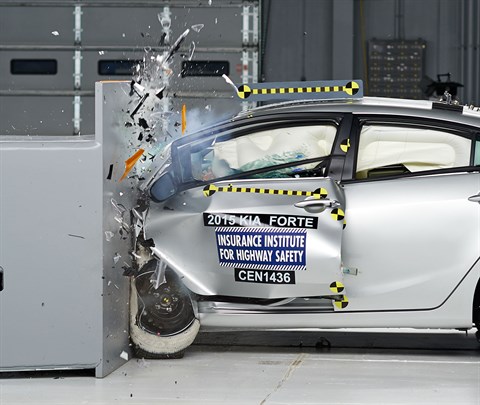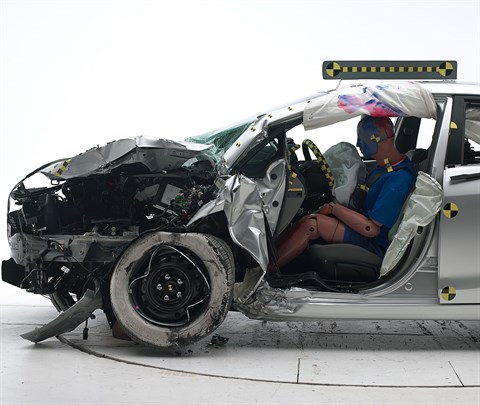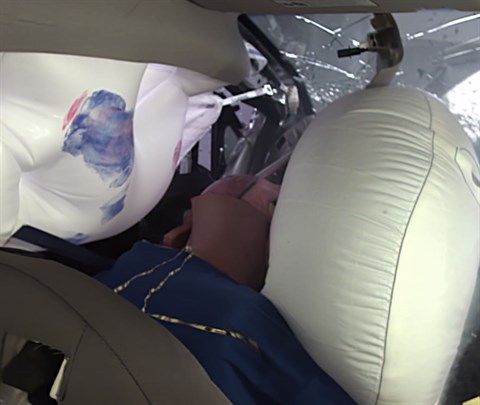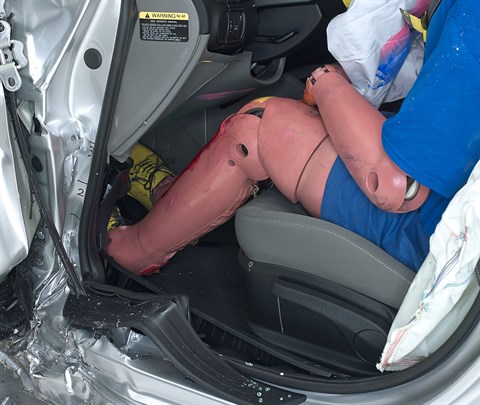- 2015 Kia Forte
- features & specs
- Reasonably well-rounded performance and attractive looks inside and out give the Forte lots of curb appeal, but disappointing safety scores and a lack of comfort mean that it isn’t quite the high achiever that the larger Optima has been.
- 2015 Kia Forte
- Small overlap front: driver-side
- Moderate overlap front: original test
2015 Kia Forte
In part because of the standard rearview camera and standard smartphone-based UVO connectivity (with subscription-free Google maps), we’d go with the Forte EX.
features & specs
Reasonably well-rounded performance and attractive looks inside and out give the Forte lots of curb appeal, but disappointing safety scores and a lack of comfort mean that it isn’t quite the high achiever that the larger Optima has been.
The 2015 Kia Forte doesn’t emulate larger sedans; with its swoopy profile and sharp styling elements, it delivers a different look than the larger Optima, as well as a choice of three body styles, plenty of design finesse inside and out, decent performance, and an excellent feature set.
It impresses as the right formula to battle best-in-class offerings from Ford and Mazda. Yet with disappointing crash-test scores, and interior comfort that just isn’t as good as it looks, we don’t recommend the Forte.
The Forte sprawled out into its new look this past year, gaining a little bit of width and length, but not height; and that works especially well in the handsome, elongated roofline and profile of the sedan. A two-door Kia Forte Koup and pert five-door Forte hatchback have also joined the lineup; but credit where credit is due, it’s tough to get the proportions right for compact sedans, and the Forte has a class advantage. Likewise, the reworked cockpit of the Forte takes a step in a sportier direction, with simple, straightforward displays that look modeled after sport sedans, with a clean layout and effective infotainment systems. The cockpit’s finished with higher-grade plastics, and the details are nicely underplayed throughout, from the round climate control knobs to the tambour-covered console storage.
Forte shoppers have a choice between a 1.8-liter, 148-horsepower four and a 2.0-liter, 173-hp four, and we’re probably go with the larger of the two, simply for its more relaxed tuning. In EX form, with only a six-speed automatic, the Forte’s drivetrain manages to remind us of some of the better 1990s-era compact cars, with its four-cylinder engine quite rev-happy and mostly vibration-free, yet quite noisy at times. The Forte isn’t all that quick, but it handles reasonably well, with some models getting three modes of steering boost, selectable via a button on the steering wheel.
Ride and handling in the 2015 Forte strike lack the firm resolve of the Focus or Mazda3, yet we’re not completely convinced that the Forte serves up any more comfort in return. The Forte’s gotten better at soaking up roughness from choppy pavement, although pavement irregularities still ring into the cabin, and the tuning of the EX model — the one we’ve spent the most time in — tends to ride an unsettling line between feeling firm in light maneuvers yet allowing a lot of body motion in more extreme ones.
With the longer, lower roofline, there’s more passenger space than before, and that’s especially noticeable in front. What’s also noticeable after just an hour or two, however, is that the front seats could use more bolstering, especially in their lower cushions. Taller passengers won’t be all that happy in front, and in back there’s simply no headroom fro them, where the low roofline is a limiting factor. However, the doors are cut in a more passenger-friendly way that allows decent entry and exit.
Despite its redesign for this past year, the Forte doesn’t meet the ever-tougher standards that savvy shoppers are going to expect for occupant protection. The Forte’s previous federal three-star frontal impact score has improved to four stars for 2015, and its IIHS small overlap rating up from ‘poor’ to ‘marginal.’ But we’re still not going to point safety-conscious families to this one.
Every Forte comes with power windows, locks, and mirrors; air conditioning; satellite radio (with three months’ free trial service); and steering-wheel audio controls. The EX gets a rearview camera and a new version of UVO that ditches Microsoft’s software for smartphone-connected links to Google maps—a light, forward-thinking solution we hope becomes the norm. On the Forte EX, you’ll even find options for leather trim, a ventilated driver seat, pushbutton start, and LED taillamps.
For 2015, Kia Forte models with the 2.0-liter engine and automatic transmission improve by several miles per gallon, to 26 mpg city, 39 highway (and an EPA 31 mpg Combined).
2015 Kia Forte
Some ratings use a scale of Poor to Good. Others range from Basic to Superior.
Small overlap front: driver-side
Rating applies to 2015-16 models
Tested vehicle: 2015 Kia Forte LX 4-door
The Kia Forte was redesigned for the 2014 model year. Beginning with the 2015 models, Kia increased the strength of the occupant compartment structure (A-pillar, door sill, seat support crossmember, among other parts) to improve occupant protection in small overlap frontal crashes.
Action shot taken during the small overlap frontal crash test.
The dummy’s position in relation to the door frame, steering wheel, and instrument panel after the crash test indicates that the driver’s survival space was not maintained well.
During the crash, the dummy’s head and torso contacted the airbag before moving to the left. The seat belt allowed the dummy to move too far forward, and the head hit the instrument panel.
Despite considerable intrusion of the door hinge pillar, door sill, and instrument panel, risk of injuries to the dummy’s legs and feet was low.
Measures of occupant compartment intrusion on driver side
| Test ID | CEN1436 |
|---|---|
| Lower occupant compartment | |
| Lower hinge pillar max (cm) | 20 |
| Footrest (cm) | 10 |
| Left toepan (cm) | 5 |
| Brake pedal (cm) | 5 |
| Parking brake (cm) | |
| Rocker panel lateral average (cm) | 6 |
| Upper occupant compartment | |
| Steering column | 6 |
| Upper hinge pillar max (cm) | 16 |
| Upper dash (cm) | 17 |
| Lower instrument panel (cm) | 15 |
Driver injury measures
| Test ID | CEN1436 |
|---|---|
| Head | |
| HIC-15 | 149 |
| Peak gs at hard contact | not meas. |
| Neck | |
| Tension (kN) | 1.5 |
| Extension bending moment (Nm) | 12 |
| Maximum Nij | 0.24 |
| Chest maximum compression (mm) | 21 |
| Femur (kN) | |
| Left | 1.4 |
| Right | 0.0 |
| Knee displacement (mm) | |
| Left | 1 |
| Right | 0 |
| Knee-thigh-hip injury risk (%) | |
| Left | 0 |
| Right | 0 |
| Maximum tibia index | |
| Left | 0.51 |
| Right | 0.61 |
| Tibia axial force (kN) | |
| Left | 1.6 |
| Right | 1.2 |
| Foot acceleration (g) | |
| Left | 108 |
| Right | 52 |
Moderate overlap front: original test
Rating applies to 2014-18 models
Tested vehicle: 2014 Kia Forte EX 4-door
The Kia Forte was redesigned for the 2014 model year. Moderate overlap frontal ratings are assigned by the Institute based on a test conducted by Hyundai/Kia as part of frontal crash test verification.
